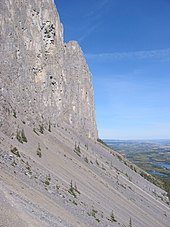
Scree is a collection of broken rock fragments at the base of a cliff or other steep rocky mass that has accumulated through periodic rockfall. Landforms associated with these materials are often called talus deposits.
The term scree is applied both to an unstable steep mountain slope composed of rock fragments and other debris, and to the mixture of rock fragments and debris itself.[1][2][3] It is loosely synonymous with talus, material that accumulates at the base of a projecting mass of rock,[2][4] or talus slope, a landform composed of talus.[5] The term scree is sometimes used more broadly for any sheet of loose rock fragments mantling a slope, while talus is used more narrowly for material that accumulates at the base of a cliff or other rocky slope from which it has obviously eroded.[2]
Scree is formed by rockfall,[3][6] which distinguishes it from colluvium. Colluvium is rock fragments or soil deposited by rainwash, sheetwash, or slow downhill creep, usually at the base of gentle slopes or hillsides.[7] However, the terms scree, talus,[2][3] and sometimes colluvium[8] tend to be used interchangeably. The term talus deposit is sometimes used to distinguish the landform from the material of which it is made.[9] The exact definition of scree in the primary literature is somewhat relaxed, and it often overlaps with both talus and colluvium.[8]
- ^ "scree". Oxford English Dictionary (Online ed.). Oxford University Press. (Subscription or participating institution membership required.)
- ^ a b c d Jackson, Julia A., ed. (1997). "scree". Glossary of geology (4th ed.). Alexandria, Virginia: American Geological Institute. ISBN 0922152349.
- ^ a b c Allaby, Michael (2013). "scree". A dictionary of geology and earth sciences (4th ed.). Oxford University Press. ISBN 9780199653065.
- ^ Jackson 1997, "talus".
- ^ Thornbury, William D. (1969). Principles of geomorphology (2d ed.). New York: Wiley. p. 66. ISBN 0471861979.
- ^ Blatt, Harvey; Middleton, Gerard; Murray, Raymond (1980). Origin of sedimentary rocks (2d ed.). Englewood Cliffs, N.J.: Prentice-Hall. p. 176. ISBN 0136427103.
- ^ Jackson 1997, "colluvium".
- ^ a b Turner, A. Keith; Schuster, Robert L. (1996). Landslides: investigation and mitigation. Washington, D.C.: National Academy Press. ISBN 0-309-06208-X. OCLC 33102185.
- ^ Brody, A. G.; Pluhar, C. J.; Stock, G. M.; Greenwood, W. J. (1 May 2015). "Near-Surface Geophysical Imaging of a Talus Deposit in Yosemite Valley, California". Environmental & Engineering Geoscience. 21 (2): 111–127. doi:10.2113/gseegeosci.21.2.111.